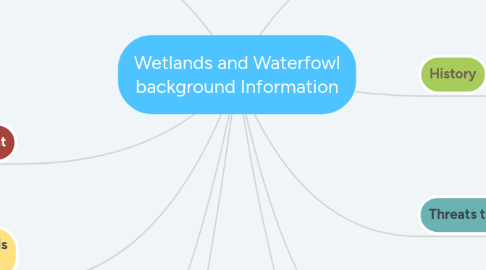
1. Major wetland types
1.1. Bogs
1.1.1. Bogs are decaying or flooded vegetation lands. Bogs are also called fens. They have many waterfowl to support many of the birds and duck species. Bogs are also very important to the animal cycle.
1.2. Swamps
1.2.1. Swamps are very similar to marshes in the amount of water you may have. One thing that is major difference is the plants. Swamps have many woods.
1.3. marshes
1.3.1. The marshes can vary in the amount of water it may have, inches to feet. the marshes have many areas of different species of waterfowl or the amount of plants in the locations.
2. Why are Wetlands Important
2.1. Wetlands play a critical part for the environment and resources society. all the animals that may live in the wetlands have a unique way o supporting the wetlands. They all relies on the wetlands for help. Many many animals stay fro shelter at the wetlands.
3. A few other things that wetlands do:
3.1. Reduce flooding and recharge the ground of the land. Reduce pollution and natural nutrients. Provide commercial or recreational value. Wetlands enrich the larger bodies of water.
4. Wetland Regulation
4.1. State and Federal legislation that regulates wetlands use and alteration
4.1.1. Many laws and rules were past for the safety of the wetlands. Many people threaten to have different things happen to the wetlands so more and more laws were past to protect them.
4.2. Further Michigan legislation that regulates alteration
4.2.1. Many of the laws affected the wetlands in a way they could not control. The natural resource society tried and pertaining the wetlands and supposing everything at the same time. They also made a thing called Parts... basically rules to help make it easy for the wetlands.
4.3. From managing Michigan wildlife's
4.3.1. With the amount of water the state of Michigan has, the water fowl is the best. They have so much resources and area to live and make a home it can change the way the wetlands and waterfowl live. They have a lot of different types of waterfowl and it helps to protect the waterfowl too.
5. Life Cycle of the Common Waterfowl
5.1. Wood duck
5.1.1. Southern birds that females lack in fat to support the eggs production. Up to 8 inches deep of water for the wood duck to survive. 12 eggs, 14 inches for nesting trees, 28 days for the female. Very good cover the home and nest location.
5.2. Blue winged Teal
5.2.1. Shallow wetlands, feed in water of 8 inches. The hens nest in upland locations. 10 eggs, 23 days. The duck also is late nesting so the wetlands are sometimes hard to keep the vegetation for the ducks.
5.3. Mallards
5.3.1. North american ducks, hens like grassy areas to lay her eggs. Nest sites are up t 500 ft away. They lay one egg each day, for 9-10 days. hens lead there ducklings into the water. Small insects are the proteins and food the ducklings eat. They young are able to fly in 50-60 days. The mallard duck eats grubs and all different small protein edible things.
6. Introduction
6.1. Many Michigan people try to go to places with many waterfowl animals to observe them.
6.1.1. Wetland and waterfowl relies on each other for support to survive.
6.1.1.1. wetlands are the most important part of the waterfowl habitats. The wetlands are all different but they all have water and fresh soil to support the waterfowl. They also help humans with flooding.
7. History
7.1. A glacier from the history changed the landscape of Michigan. The land was covered in water creating wetlands and the land was in a different condition.
7.1.1. Wetlands helped the settlers that were there support for the survival. Also the animals in the area had to adapt and change location or living styles to live there.

